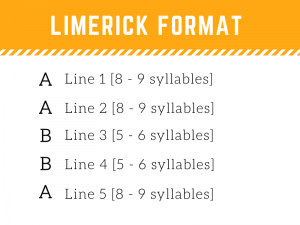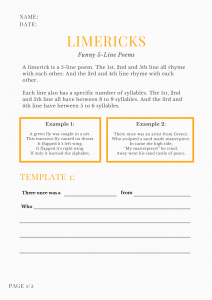How to Write a Limerick in 5 Steps + Examples
Did you know that the earliest example of limericks were written up to 500 years ago? To celebrate this funny and humorous form of poetry, May 12th is national limerick day. This is the perfect day to start learning how to write your own limericks. And to help you out, we have created this brilliant step-by-step guide on how to write a limerick with examples.
Qualities of a Limerick
Before you begin limerick writing. Here are a couple of things that all limericks have in common:
- They are five lines long
- They all follow the following rhyme scheme: AABBA rhyme scheme – the first line must rhyme with the 2nd and 5th line. And lines 3 and 4 must rhyme.
- They are usually funny or silly
- The last line is usually the funniest.
How to write a limerick in 5 steps
To write a limerick, you must have a stanza of 5 lines. The first, second and fifth line are rhyme with each other. While the third and fourth line rhyme with each other. You also need to consider the syllables on each line. The first, second and fifth line all have between 8 to 9 syllables. And the third and fourth line have between 5 to 6 syllables.
Here is a simple limerick poem format for you to follow:

Step 1: Brainstorm ideas:
Before even starting to write a limerick, it is a good idea to read a couple of examples. Reading examples will help you understand what a limerick sounds like and what they are all about. Once you have understood the style of limerick, it’s time to start brainstorming.
On a piece of paper start writing down some funny poem ideas. You might think about something that happened recently that made you giggle or something you saw on TV or read in a book that made you laugh. If you are still struggling for ideas, you can try using the “What If” technique. For example, what if a bear could talk? Or if you had wings?
Limerick ideas to try:
Wondering what to write a limerick about? Limerick ideas can come from anywhere, at anytime. To help you out, here are some fun limerick ideas to inspire you. Try writing a limerick poem about any of the following ideas:
- A lazy house cat
- Clumsy old monkey
- Angry little goat
- A vegetarian zombie
- Sad young prince
- Big, grumpy bulldog
- A handsome zookeeper
- A boy named Jack
- Jazz singer from New York
- A whimsical fairy
These ideas could make great starting sentences for your limerick.
Step 2: How to start a limerick:
Now that you have a couple of funny ideas to help you, it’s time to write your first line. The first line of a limerick is normally the easiest, as it either ends with a person’s first name or the name of a city, town or country. Therefore when selecting the last word in your first sentence make sure you choose something simple, which is likely to have many words that rhyme with it.
For example:
There was once a quiet girl named Kate.
Step 3: Find words that rhyme with your first line:
Use a rhyming dictionary to find words that rhyme with the last word in your first sentence. Make a list of words that rhyme and select the ones that are most relevant for your limerick.
Using the example from step 2:
Late, Date, Mate, Rate, Great, Debate, State, Separate, Collaborate, Wait…
Step 4: Write your 2nd and last line:
Make sure your last line is extremely funny or something that is out of the ordinary.
For example:
There was once a quiet girl named Kate.
One day she came to school late.
We then noticed the word “wait” would be the perfect word to include in the last sentence:
“Stop! You’ll have to wait!”
Step 5: Write lines 3 and 4:
You might need to change line 5, so it makes more sense:
For example:
There was once a quiet girl named Kate.
One day she came to school late.
When her alarm went off
She jumped up and took off
Then her cat yelled, “Hey wait!”
We changed the last sentence to make it sound more unusual and funny.
Limerick writing template
Here are some sample limericks for you to download, along with a free 2-page limerick template printable for you to use:

Download free limerick template printable.
Share your limerick poems with us!
It’s time to write your own limerick! We hope that our step-by-step instructions on makes writing limericks a whole lot easier. We would love to read your limerick poems! Just post your poetry in the comments below.
Interested in more poetry? Take a look at our posts, how to write your first-ever haiku and tips for writing a Clerihew poem. And for some added extra fun, why not create your own comic strip?






Comments loading...